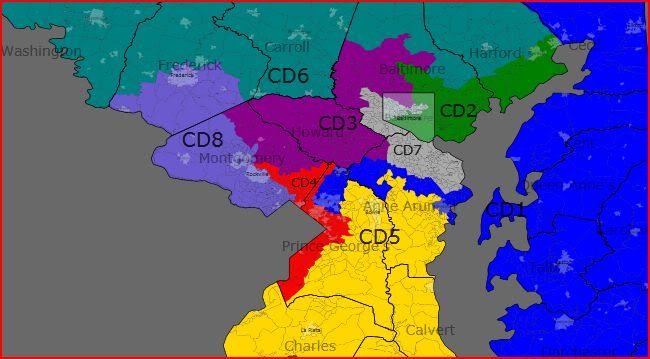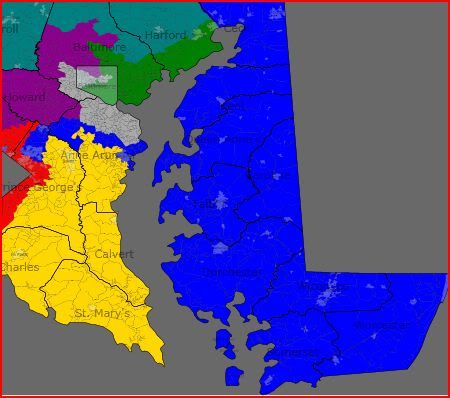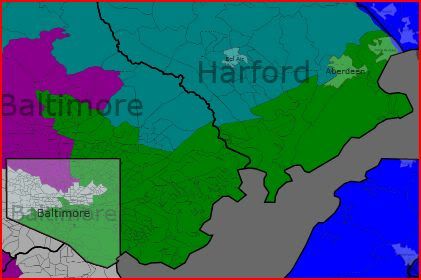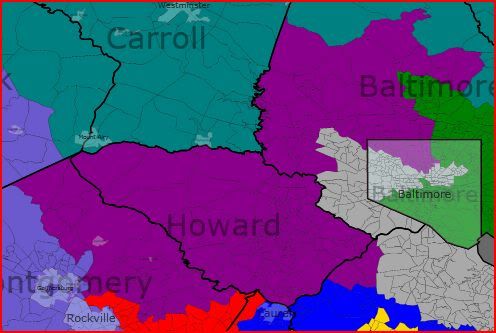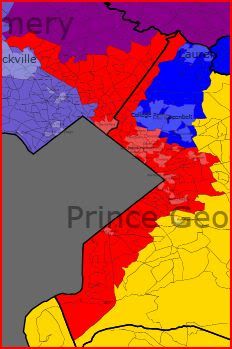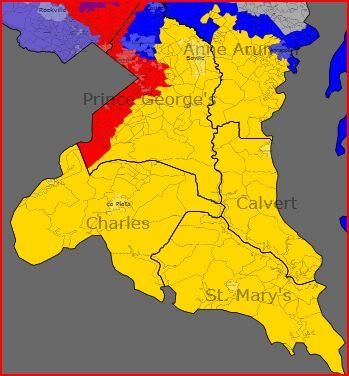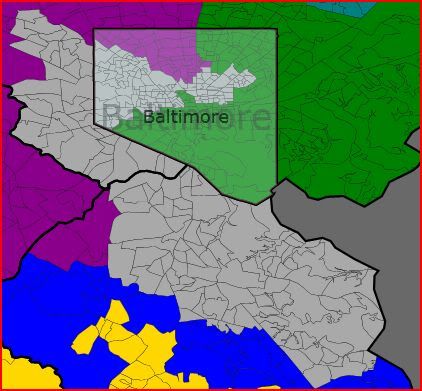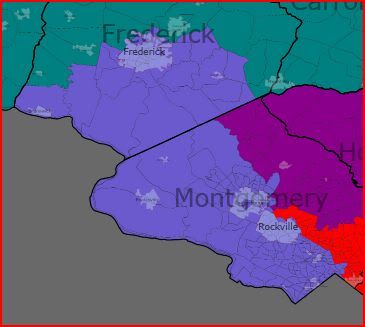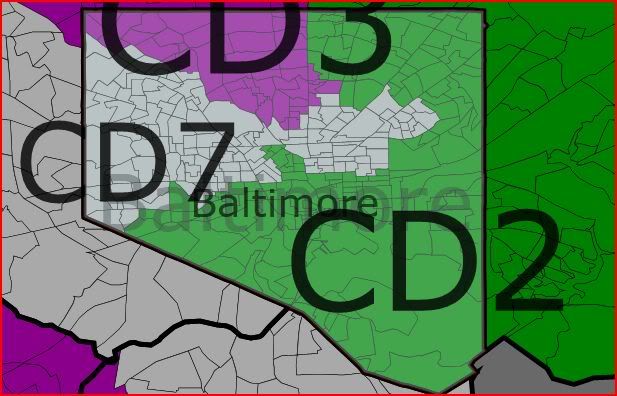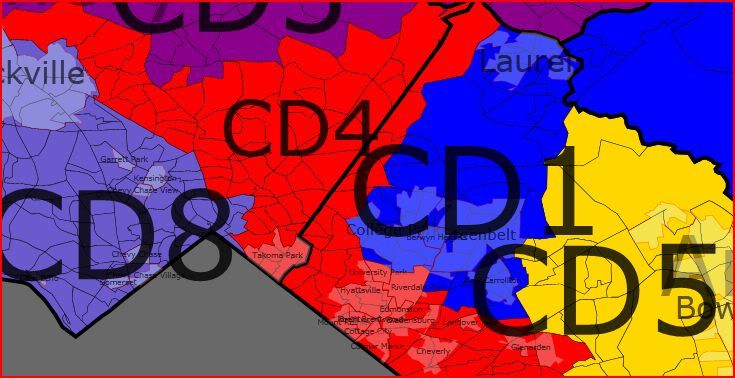This is the final installment in a four-part series about the 2010 Democratic Primary for States’ Attorney for Baltimore City in Maryland.
Why is this race notable? Well, the result, an upset win by challenger Gregg Bernstein over incumbent States’ Attorney Patricia Jessamy, challenged a lot of widely-held assumptions about racial dynamics in large cities and how one can win elections in the City of Baltimore and perhaps other similar jurisdictions.
Not to rehash the introduction, but since it’s been a while now… Jessamy had been pretty popular among the Black majority in Baltimore but was strongly disliked by the law enforcement community and had a feud with then-Mayor Martin O’Malley about police tactics. She was re-elected in 2006 with 71.52% of the vote against an largely unknown opponent in the Democratic primary named Aaron Fogleman who ran a minimal campaign. Fogleman nonetheless won nearly half of the White vote, and about 15% of the Black vote.
So not many people gave Gregg Bernstein much of a chance when the campaign got off to a slow start in the spring, but the skeptics, myself included, were proven wrong…
For a broad overview of what’s going on here, check out Part 1. For a summary of the methodology I used and what I looked for, check out Part 2. For a whole bunch of data about Baltimore elections and my attempt to put them in the context of what I expected to see when I looked at the election that was the subject of this series, check out Part 3.
To refresh your memory, I classified Baltimore’s voting precincts (based on data from Dave’s App, which unfortunately is out of date b/c the city did a lot of precinct consolidation between 2000 and 2006) into six categories and twenty zones:
By Category:
Type I: Red on the map. More than 70% White, less than 5% Hispanic and Asian population. Mostly found on the periphery of town. The Federal Hill, Mt. Washington, Roland Park, and Hampden areas consisted mostly of such precincts.
2006: Jessamy 7311 (51%), Fogleman 6932 (49%)
2010: Bernstein 10127 (79%), Jessamy 2447 (19%), Lansey 290 (2%)
Type II: Green on the map. More than 5% Hispanic. (Most of these were predominantly white, but two were otherwise predominantly black.) The lion’s share of these precincts were in Fells Point, Canton, or Highlandtown.
2006: Jessamy 1649 (50%), Fogleman 1630 (50%)
2010: Bernstein 2290 (77%), Jessamy 595 (20%), Lansey (3%)
Type III: Yellow on the map. More than 5% Asian. (Most of these were predominantly white, but two were otherwise predominantly black.) Most of these precincts were found in Downtown/Midtown or Charles Village, with a few that marginally qualified in Hampden.
2006: Jessamy 2331 (55%), Fogleman 1871 (45%)
2010: Bernstein 2994 (75%), Jessamy 898 (23%), Lansey 76 (2%)
Type IV: Gray on the map. None the above, but with more Whites than Blacks. They were scattered across town, with a cluster of them is in Northeast Baltimore.
2006: Jessamy 1706 (64%), Fogleman 976 (36%)
2010: Bernstein 1287 (58%), Jessamy 851 (38%), Lansey 91 (4%)
Type V: Teal Blue on the map. None of the above, more Blacks than Whites but Black population less than 70%. They are also scattered across town, and Northeast Baltimore has a cluster of them.
2006: Jessamy 3438 (71%), Fogleman 1386 (29%)
2010: Bernstein 1848 (48%), Jessamy 1837 (48%), Lansey 139 (4%)
Type VI: Blue on the map. More than 70% Black, less than 5% Hispanic and Asian. The West Baltimore, East Baltimore, and Forest Park/Arlington zones consist exclusively of such precincts; the Near West Baltimore, Frankford, Govans/Northwood, Waverly/Montebello, and Park Heights zones consist mostly of such precincts.
2006: Jessamy 33413 (83%), Fogleman 6841 (17%)
2010: Jessamy 19200 (66%), Bernstein 8760 (30%), Lansey 1324 (5%)
By Neighborhood:
[Note: Part 3 of this series contains more detailed descriptions of each of these clusters of neighborhoods than can be found here.]
Brooklyn/Cherry Hill [dark blue]:
2006: Jessamy 1131 (71%), Fogleman 473 (29%)
2010: Jessamy 705 (49%), Bernstein 633 (44%), Lansey 104 (7%)
Traditionally working class and racially mixed south Baltimore sums up Pat Jessamy’s whole problem in this re-election, even though she retained a bigger share of her 2006 vote total here than in the city as a whole. It was also the best-performing region for little-discussed third candidate Cheryl Lansey, also an African-American female, accused of being a spoiler candidate by Jessamy supporters.
Federal Hill/Locust Point [dark green]:
2006: Fogleman 1013 (55%), Jessamy 823 (45%)
2010: Bernstein 1759 (86%), Jessamy 231 (11%), Lansey 58 (3%)
The whitest and generally most Republican-voting part of town (in 2006, Ehrlich topped 40% here while Steele topped 35%; in 2008, McCain fell just short of 35%, all very high for Baltimore) had already thought so little of Pat Jessamy that they voted for someone who barely campaigned over her in 2006. Bernstein swept all 10 of it’s precincts; one precinct, 24-02, gave the incumbent 4 votes of 90, her worst showing in the entire city. In context these numbers are unsurprising. But 11% is really low, and, even worse for Jessamy, this was one of only three zones to have a higher vote total in the 2010 primary than in the 2006 one.
Southwest Baltimore [purple]:
2006: Jessamy 637 (54%), Fogleman 542 (46%)
2010: Bernstein 793 (70%), Jessamy 298 (26%), Lansey 47 (4%)
This area is another part of town that tells the story in miniature. Jessamy went from carrying six of its nine precincts to carrying only one, and even in that one (20-11) she went from 62% of the vote to 46%. The big thumbs down came from precinct 25-04, one of only five precincts to be carried by John McCain.
Edmondson [red]:
2006: Jessamy 2840 (80%), Fogleman 691 (20%)
2010: Jessamy 1668 (61%), Bernstein 963 (35%), Lansey 96 (4%)
And here’s where we learn that it was a multi-racial coalition that brought down Pat Jessamy.
Jessamy carried every precinct here but except for 28-15…but these areas supported black candidates over white ones big time (84% for Obama in his ’08 primary, 81% for Mfume in his ’06 Senate primary) in every previous election I looked at. While some of these precincts actually have sizable a sizable white minority, the ones further away from the county line don’t, and Bernstein was still getting in the 30% range in most such precincts, and that’s worth noting.
West Baltimore [mustard yellow]:
2006: Jessamy 5364 (85%), Fogleman 944 (15%)
2010: Jessamy 3056 (69%), Bernstein 1112 (25%), Lansey 241 (5%)
This one is partially about the ability of Bernstein to get at least some measure of the vote even in an area like this one (and this was his worst showing in town) where nearly everyone is both black and poor and suspicion of law enforcement tends to run high. But it’s mostly about the lack of turnout. Bernstein got 200 more votes than Fogleman did, which isn’t much; the real story is Pat Jessamy coming out of this area with a net loss of nearly 2,300 votes. That hurts.
Near West Baltimore [teal blue]:
2006: Jessamy 2539 (80%), Fogleman 641 (20%)
2010: Jessamy 1551 (64%), Bernstein 750 (31%), Lansey 116 (5%)
Same as above, but shifted five points since there are some urban gentrifiers here. I wondered if their effect would an amplification of a shift away from Jessamy. It did not.
Downtown & Midtown [gray]:
2006: Jessamy 1107 (56%), Fogleman 874 (44%)
2010: Bernstein 1297 (60%), Jessamy (36%), Lansey 75 (3%)
I wonder if the demographics of this area may have shifted some in four years as it covers the booming Harbor East district. Either way, it went from a set of precincts that ranged between being indifferent towards and relatively friendly towards the incumbent turned hostile. In 2006 Jessamy carried 13 of these 15 precincts, tying in another, and losing one (11-05) by two votes. This time, Bernstein carried 11 of them. Even worse for Jessamy, this was the other area that cast substantially more votes in the 2010 primary than the one four years earlier, which possibly reflects the revitalization of central Baltimore vis-a-vis the rest of the city. (Interesting side note: Bernstein’s people were all over Baltimore Pride events this summer; Bernstein cleaned up in four precincts with large gay populations in Mt. Vernon and Bolton Hill that were some of Jessamy’s best predominantly white precincts in 2006.)
East Baltimore [gray-blue]:
2006: Jessamy 3822 (85%), Fogleman 666 (15%)
2010: Jessamy 2224 (69%), Bernstein 859 (27%), Lansey 157 (5%)
See West Baltimore above. Proportions are almost exactly the same. The presence of Johns Hopkins Medical School is probably the main difference.
Fells Point & Canton [aqua]:
2006: Fogleman 1219 (56%), Jessamy 953 (44%)
2010: Bernstein 1726 (83%), Jessamy 306 (15%), Lansey 58 (3%)
Much like Federal Hill, except with a larger Hispanic population and somewhat more liberal political outlook as a whole (it’s around 4-5 points more liberal and more Democratic than Fed Hill, Obama overperformed a little as well.) However, it had giving Jessamy her worst showing in 2006. And it was the site of the infamous Zach Sowers beating a few years back, in which Jessamy’s spokeswoman was berated for insensitivity to the family and community, so Jessamy had to know she was going to get crushed here.
Highlandtown [magenta]:
2006: Fogleman 970 (52%), Jessamy 895 (48%)
2010: Bernstein 1241 (80%), Jessamy 247 (16%), Lansey 56 (4%)
This southeastern part of town has more of a working class flavor than touristy Fells Point and yuppie haven Canton. Much like the East Side of Baltimore County (Dundalk, Essex) it borders, it’s got a reputation for Reagan Democrats none too fond of voting for black candidates. It’s where Barack Obama had his worst showing in town (Hillary Clinton got 57% of the primary vote, nearly 15 points more than any in other part of the city; John McCain got 37% of the general election vote, his best showing in the city) in 2008. Just to confuse everyone though, Pat Jessamy did carry the area in 2006, albeit barely. In 2010, Highlandtown was not Pat Jessamy’s worst area…but it was plenty bad enough at an even 16%.
Frankford [lime green]:
2006: Jessamy 3076 (81%), Fogleman 738 (19%)
2010: Jessamy 1753 (59%), Bernstein 1059 (36%), Lansey 169 (6%)
Predominantly black (middle-class black specifically) but not monolithic, Jessamy lost 22 points and 1,300 votes here. A decent chunk of voters took the third option with Cheryl Lansey here, and in this area she was stronger where Jessamy was also strong as opposed to where Bernstein was strong, suggesting that the spoiler factor may have been key. Jessamy won 13 of the 15 precincts here, but mostly with numbers in the 50s and 60s rather than the 70s and 80s she got last time around.
Northeast Baltimore [light blue]:
2006: Jessamy 3467 (61%), Fogleman 2172 (39%)
2010: Bernstein 2806 (60%), Jessamy 1701 (35%), Lansey 160 (3%)
Here’s one battleground where the Bernstein campaign did some heavy lifting, the area’s voting patterns doing a near-perfect 180 degree turn. Jessamy carried 18 of 22 precincts in her 2006 re-election, and Bernstein flipped all but two of them this time out for 20 of 22. There are more whites than blacks here, but neither Mfume (51% in his Senate primary) nor Obama (71% primary, 79% general) had that much trouble getting votes in this part of town; if I had to credit one part of town with being the tipping point, I’d probably cite this one as the most pivotal.
Govans/Northwood [peach]:
2006: Jessamy 5137 (82%), Fogleman 1124 (18%)
2010: Jessamy 2695 (62%), Bernstein 1524 (35%), Lansey 147 (3%)
This is where Pat Jessamy lives. Ouch. If she had gotten everyone in her own neighborhood who voted for her in 2006 to do so again, she would have squeaked by. Instead, she lost 400 votes to the white challenger, 147 votes to a random black challenger, and 1895 votes – enough by itself to put her over the top – to non-turnout. (Some people might have moved away; we’ll learn more when the new Census data emerges.) This was, incidentally, the second biggest turnout drop in the city after Park Heights; my postulate about middle-class black areas like this one holding turnout better between elections than poor areas turns out not to have held, at least in Baltimore.
Waverly/Montebello [olive]:
2006: Jessamy 2547 (81%), Fogleman 590 (19%)
2010: Jessamy 1465 (60%), Bernstein 843 (35%), Lansey 114 (5%)
There are 12 precincts in this zone. Jessamy carried all of them both times. But instead of racking up numbers between 73-88%, they ranged from 51-70% instead. Couple that with the dropped turnout, and it spelled trouble for the incumbent as well as evidencing the fact that it wasn’t just a matter of Bernstein racking up the big numbers in white parts of town.
Roland Park, Guilford & Homeland [orange]:
2006: Jessamy 2005 (52%), Fogleman 1880 (48%)
2010: Bernstein 3082 (85%), Jessamy 534 (15%), Lansey 25 (1%)
In addition to being the wealthiest part of Baltimore, this is Bernstein’s home turf and does it ever show. Previously somewhat less hostile to Jessamy (it’s mostly liberals, and there’s just not much crime up there to complain about) than other white parts of town..one of their own put up huge numbers. (If Northwood had done for Jessamy what Roland Park did for Bernstein, Bernstein would have lost.) Bernstein’s 37 point improvement on Fogleman in this zone put him over the top.
Charles Village [light green]:
2006: Jessamy 1000 (64%), Fogleman 554 (36%)
2010: Bernstein 873 (63%), Jessamy 462 (34%) Lansey 44 (3%)
The other big 180 reversal. It’s relatively integrated and chock full of liberals of all colors (they liked Mfume and loved Obama..but black Republican Michael Steele saw perhaps his worst numbers in the entire state there) that match the brightly colored houses that famously line some of its blocks. Jessamy won a comfortable 63% of the vote there last time.
What happened here? Well, early this summer, an unarmed Hopkins graduate student was murdered in a robbery in broad daylight on a Charles Village street thought to be reasonably safe by a guy with a rap sheet a mile long. And people were pissed. Jessamy went to a community memorial for the student and got, to put it mildly, a very chilly reception. It was perhaps the flashpoint of the election.
Hampden [indigo]:
2006: Fogleman 937 (56%), Jessamy 733 (44%)
2010: Bernstein 1460 (87%), Jessamy 200 (12%), Lansey 21 (1%)
Bernstein did even better here than in neighboring Roland Park, not that he needed to do much to convince Hampdenites to not vote for Jessamy. The area has fewer blacks per capita than anywhere else in town and has long had a reputation for hostility towards black politicians (and towards non-politicians as well) although the reality is now somewhat more complicated by an influx of new residents and a softening of some old attitudes. Barack Obama found more support (56% primary, 72% general) than one would expect based on the old stereotypes.
But, yeah, everybody knew going in Pat Jessamy was not going to find much support here. I might have expected more than 12% though; Jessamy only got 20% in precinct 12-03, which is quite a bit more diverse than the rest of the area. Aaron Fogleman did about that well in West Baltimore and he barely campaigned. Also: note how few votes for Lansey there were here and in other mostly white areas.
Mount Washington/Cross Country [light-yellow]:
2006: Jessamy 2616 (57%), Fogleman 1988 (43%)
2010: Bernstein 2653 (73%), Jessamy 921 (25%), Lansey 74 (2%)
Pretty dramatic turnaround here too. In 2006 Jessamy won 9 of 11 precincts. The other two are part of an three-precinct [27-64, 27-65, and 27-66] cluster consisting largely of Orthodox Jews in the city’s NW corner; in general elections, McCain won all three precincts, Ehrlich won two of them, and all three were strong for Hillary in the ’08 primary.) This time around, Jessamy only carried a single precinct, 28-01, whose demographics are quite different than the others in this zone. Bernstein cleaned up in the Orthodox zone but almost as well in the rest of Cross County and even in more liberal Mount Washington Village.
Park Heights [yellow-green]:
2006: Jessamy 2821 (82%), Fogleman 618 (18%)
2010: Jessamy 1578 (70%), Bernstein 597 (26%), Lansey 93 (4%)
The good news for Jessamy is that she held a higher percentage of her 2006 vote here than anywhere else in the city, and it’s the only part of town where Bernstein actually failed to match Fogleman’s vote total from 2006. The bad news is that turnout in this largely struggling area dropped 34% from 2006. So Jessamy’s vote margin here was nonetheless cut in half.
Forest Park/Arlington [pink]:
2006: Jessamy 5720 (85%), Fogleman 975 (15%)
2010: Jessamy 3459 (71%), Bernstein 1265 (26%), Lansey 156 (3%)
This biggest redoubt of black middle-class voters in the city were more loyal to Pat Jessamy than her own neighbors further east, or, indeed, than anywhere else in the city. Furthermore, unlike many largely black areas, they didn’t even give Cheryl Lansey much support. But 30% fewer Forest Park-Arlington residents turned out this time around, and that spelled nearly 2,300 votes out of this area.
So…in the final analysis, where did all this number crunching get me? I found three things that I think mattered and three things that I think didn’t.
1. Whites voted as a bloc for Bernstein in a way that they had not done for any other candidate in any of the several races I examined for this diary. I estimate Jessamy’s 2010 level of support among Whites to be somewhere around 15%, as compared with about 50% for Jessamy in 2006, about 35% for Mfume in 2006, and about 55% for Obama in the 2008 primary. I created a mathematical model whereby Shifting just 3% of the vote in the non-Type VI precincts back to Jessamy across the board (which still leaves her support among whites down near 20%, mind you) would have been enough to get her re-elected by 87 votes.
2. The deterioration of support for Jessamy among Blacks was also a contributing factor. She lost 16 points of support in Type VI precincts. I created a model whereby Jessamy’s support in Type VI precincts was raised while everything else (including the surprisng result, even knowing my source data had some noise in it, whereby Bernstein got more votes than Jessamy in Type V precincts) constant. Even when taking into account depressed black turnout (which I’ll discuss below) in a scenario when her support in the Type VI precincts is raised from 66% to 69%, still a 13-point drop, Jessamy gets re-elected by the narrowest of margins.
3. Turnout among Black voters was an issue. If the relative share of the total vote the 20 zones had held constant from 2006, even with the 2010 candidates keeping the same proportion of votes from each zone (in other words, this time I locked in Jessamy’s dismal performance in White areas and reduced performance in Black areas) the result would be reversed, with Jessamy winning over Bernstein 49-47. (I didn’t do the math on 2008, because it became obvious to me quickly that that electorate would have chosen Jessamy over Bernstein as well.)
And three things I didn’t find to be important in the end:
1. The Lansey-as-spoiler factor. Certainly Jessamy supporters were angry with her, before and especially after the election. It’s hard to model with any confidence. Lansey’s vote total of 2011 was less than the 1456 vote margin between Bernstein and Jessamy. I know little about Cheryl Lansey and couldn’t figure out what her agenda was, other than not liking Jessamy, so that makes it tough to read voter minds. That most of her votes came from black neighborhoods suggests that Jessamy supporters had a reason to be unhappy. However, a Bernstein supporter could argue that her presence on the ballot as a third option gave people dissatisfied with Jessamy but reluctant to support a white challenger an easy way out of their dilemma and that at least some of those voters would have opted either for Bernstein or for a blank ballot. Even without Bernstein getting a single one of the the Lansey votes, Jessamy would have needed 72.5% of those votes to win. Since that figure was above her regular numbers in all but her very best precincts, I don’t think she was the difference in the election.
2. There wasn’t enough of a difference between precincts with significant Hispanic or Asian minorities and those without them to support any effort to distinguish them from similar precincts that happen to lack significant Hispanic or Asian minorities.
3. I didn’t find any useful class-based distinctions in the data. In Black precincts, racial makeup (i.e. whether there’s much of a non-Black minority) explained the variances in election results much better than class makeup did, as usual for Baltimore elections of this type. Though there are often sizable gaps between results in White precincts in Baltimore that speak to real or perceived class differences, those were at best very muted with regards to this election, as these different neighborhoods acted in unison this time out.
Conclusion:
It took a near-perfect storm of high dissatisfaction among Whites, at least moderate dissatisfaction among Blacks, and low Black turnout to produce this surprising upset victory.


